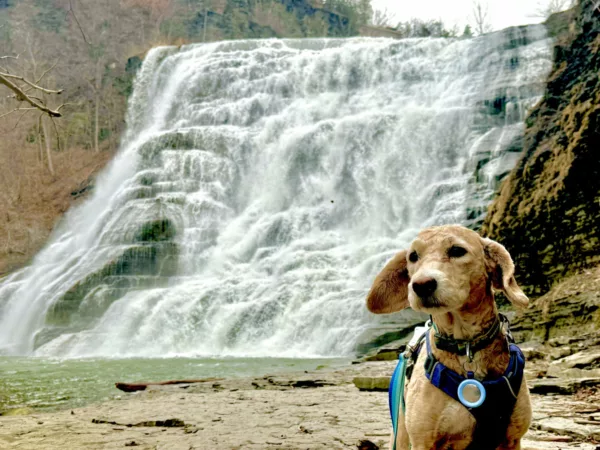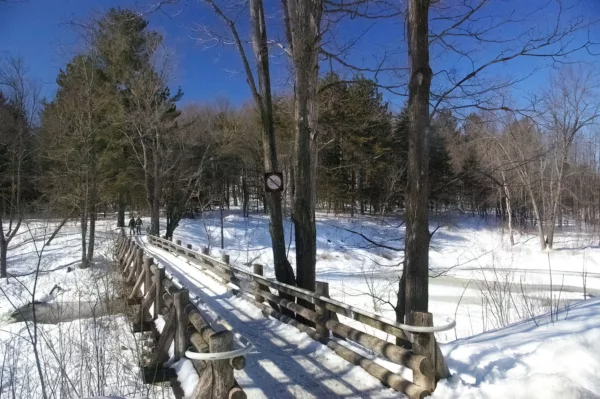10 Ways to Improve Your Hiking Experience

You’d love to hike more—if it weren’t for the blistered feet, aching quads, out-of-breath-wheezing and overall complication of getting prepped and finding a worthy trail.
Well…
We’re going to solve all of those problems and more. We’re going to get you outside and hiking regularly. We’re going improve your overall experience.
Whether you need these tips for yourself or for your reluctant partner—read on to discover 10 ways to hike further and faster and have more fun than ever before.
1. Socks Matter

Everyone gabs about hiking boots—proper fit, sturdy support, waterproofing. Good boots are important, sure, but it’s all for nothing if you wear the wrong socks. Cotton? Forget about it; cotton will rip your feet to shreds. Ankle-height? Not unless you like chaffing. Look for wool and wool-blend (30 per cent wool or better) socks with anatomic shapes (heel cups and arch contours) and above-ankle to mid-calf heights. I can’t overstate this: good socks matter as much as good shoes.
2. Don’t Hunch!

I’ve seen way too many people hike up mountains hunched over and looking at the ground, usually due to either exhaustion or a natural desire to watch their footing. Problem is, hunching over restricts your breathing. I’ve seen the same people confuse this breath-impairment with the effects of elevation—the higher up you hike, the harder it is to breathe—when in fact it’s just posture causing the problem. (Elevation won’t come into effect until 2,000 metres or more.) Stand up straight, breathe deep the fresh mountain air and feel a rush of energy flow through your body.
3. Get Isometric & Eccentric

After a long hiking descent, I often find the tops of my quads (Rectus femoris) ache beyond reason. Last fall, I did a steep scramble in Alaska—the hike didn’t challenge me, yet my quads absolutely burned after the downhill. It was a mystery, until fitness trainer Curb Ivanic told me about “eccentric contractions;” when your muscles are lengthening while they are contracting, as they would on a descent.
His words: “Eccentric contractions cause more damage to the muscle tissue than other types of contractions, hence they result in increased soreness.” His fix: repetitions of isometric squats (hold the bottom position of a squat for five to 10 seconds) and eccentric squats (lower into the squat slowly over five to 10 seconds, then lift at a regular pace). Consider these principles for other ache-prone muscle groups as well.
4. Cadence Counts

The tortoise and the hare got it half right, anyway—fast and steady wins, not slow and steady. (Who ever won by going slow?) The ultimate key to both, though, is steady. A short burst of energy followed by hours of foot-dragging is a surefire way to make any hike miserable. Experienced long-distance trekkers pick a pace they can maintain for hours and stick to it, step-by-step-by-step. Maintain a steady cadence and you’ll have energy to spare; the better your fitness, the quicker your cadence.
5. Drink Up (But Not Too Much)

Do you know what hyponatremia is? It’s when the sodium level in your blood dips to a dangerously low level. This can happen when you drink way too much water without getting proper nutrition in between sips. You’ll have to be really guzzling the stuff, like more than a litre per hour for a sustained duration (sans food), but the initial effects are similar to those of dehydration.
So ensure you stay properly hydrated—just don’t overdo it. (Sort of a hiker’s “damned if you do, damned if you don’t” moment.) Aim to drink small sips of water regularly. Similar to tip #4 about maintaining cadence in your step, you’ll want to maintain a cadence in your drinking. High heat and humidity requires intake adjustments, as does extreme cold. Guzzling massive amounts of water all at once does very little, and if you wait until the effects of dehydration kick in—it’s too late. It’s all about balance. Which leads us to…
6. Core & Balance

Squats are a hiker’s best friends (as noted in #3), but they’re not your only friends. Strengthening your core muscles should be a daily routine; it will help in everything from posture (see #2) to overall endurance (see #9). The best way to strengthen your core is also the most lamented—The Plank. How do you do it? Get into a pushup position, then rest your weight on your forearms with elbows directly below shoulders. Keep your back straight to your toes and hold the position for as long as you can. Start with 30 seconds, then add five seconds per week, planking daily.
You may have also noticed your usual hiking trails are less-than-smooth. Strengthening your stability muscles and working on your balance not only increases overall fitness, but reduces the chances of accidents like twisted ankles and trip-and-falls. Do this by simply standing on one leg—with your eyes closed—regularly and for extended periods of time.
7. Eat, Dammit!

Hiking can easily burn 500 calories per hour. Do the math—a six-hour hike will burn off everything you might normally eat in an entire day. So it’s not just about cheat-eating chocolate and cookies knowing you’ll torch those calories in a couple hours. It’s about maintaining your energy level so you can enjoy the hike and tackle the trail with gusto. No one likes to hike while hangry. (OK, it’s a little about cheat-eating too—that’s why a post-hike poutine tastes so darn good.)
8. Go Walkabout

As you’ve noted thus far, there are several dedicated exercises that will help you hike faster and further. Here is a not-so-dedicated exercise: walk. The more you wear out your soles, the better a hiker you’ll be. Walk to the grocery store. Walk to work. Walk to the pub, then definitely walk home. Walk on your lunch breaks (I do 30 minutes every noon). Just walk. When your legs are trained to move relentlessly from day-to-day walking, a steep hike will feel, well, like a walk in the park.
9. K.I.S.S

It’s early on a sunny Sunday. Today, you’re going hiking. Now, if you could just remember where you stashed your daypack. Found it! Wait, where’s the hydration bladder? (Eww, it smells weird.) Where are your boots? Which jacket should you take? Let’s just grab some Band-Aids and moleskin too. Where are your merino socks? Oh, you’ll have to stop for snacks en route and… it’s past noon and you’re just arriving at the trailhead.
Sound at all familiar?
I keep my daypack in the front closet, pre-stuffed with basic first-aid gear and equipment. My boots are clean, dry and ready to grab. My apparel is well-sorted. And I only buy performance socks, so I always have them on. I can be out of the house in minutes, when the hiking bug bites. The more complicated you make your life, the more you’ll want to sit it out. So Keep It Simple, Stupid.
10. Download Our Free E-Book: “Canada’s 35 Greatest Hikes”

You have the when sorted (today!). After this list, you’ll have the how too. The why is obvious to any true hiker. But what about the where? Let us help you with that too. We researched 35 of Canada’s BEST hiking trails, from Pacific, to Atlantic, to Arctic coasts (and everywhere in between) to create this exciting new, totally FREE, e-book.
We have hikes that will take an hour and hikes that will take a week; hikes for pros and hikes for kids; hikes in remote wilderness and hikes just outside your city. All are sorted geographically and come with detailed trail descriptors and difficulty ratings. And it’s our gift to you. Happy hiking!
>>>CLICK HERE for instant access to CANADA’S 35 GREATEST HIKES.
<div class="articleLink">
<div class="articleImage"><a href="Canadas-35-Greatest-Hikes" class="imageBox" style="background-image: url('https://explore-mag.com/wp-content/uploads/2024/02/68567_max.png');"> </a></div>
<a href="Canadas-35-Greatest-Hikes" class="articleLinkTitle">35 of Canada's best hikes</a><br>
<div class="articleLinkText">All new! We scoured Canada from the West Coast, to the Maritimes, to the remote Arctic, and uncovered Canada's 35 Greatest Hikes

















